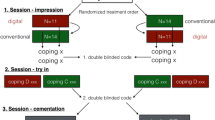Abstract
Objectives
To evaluate the marginal and internal fit of CAD/CAM-generated frameworks for 4-unit, fixed dental prostheses (FDPs) from zirconia (Z) and cobalt-chromium alloy (C) made with conventional (CI) and digital impressions (DI).
Materials and methods
A titanium model was digitized with an intraoral scanner (DI, LAVA™ C.O.S.; 3M ESPE; Seefeld, Germany; n = 12). Additionally, 12 conventional impressions were taken, and referring plaster casts were digitized by a laboratory-scanner (CI, LAVA™ Scan ST; 3M ESPE; n = 12). Frameworks were fabricated (3M ESPE) from cobalt-chromium (DI-C, n = 12; CI-C, n = 12) and zirconia (DI-Z, n = 12; CI-Z, n = 12) from the same datasets. A replica technique was applied to measure the accuracy. The Mann–Whitney U statistical test was applied to detect statistical differences between each material and methodology groups in terms of fit.
Results
Frameworks from DI-C (median 19.07 μm) showed significantly better marginal fit than CI-C (median 64.64 μm, p < 0.001). Frameworks from DI-Z (median 52.50 μm) showed significantly better marginal fit than CI-Z (median 72.94 μm, p = 0.001). Additionally, frameworks from DI-C showed a significantly better marginal fit than DI-Z (p < 0.001).
Conclusions
CI and DI led to a clinically acceptable marginal fit of 4-unit FDPs from cobalt-chromium and zirconia. DI leads to better marginal fit of the cobalt-chromium frameworks; however, no effect on zirconia was found.
Clinical relevance
The results indicate that DI is suitable for fabricating 4-unit, cobalt-chromium and zirconia frameworks with regard to fit requirements.





Similar content being viewed by others
References
Hondrum SO (2001) Changes in properties of non-aqueous elastomeric impression materials after storage of components. J Prosthet Dent 85:73-81.
Thongthammachat S, Moore BK, Barco MT 2nd, Hovijitra S, Brown DT, Andres CJ (2002) Dimensional accuracy of dental casts: influence of tray material, impression material, and time. J Prosthodont 11:98-108.
Wassell RW, Barker D, Walls AW (2002) Crowns and other extra-coronal restorations: impression materials and technique. Br Dent J 192:679–84, 687-690.
Beuer F, Naumann M, Gernet W (2009) Precision of fit: zirconiathree-unit fixed dental prostheses. Clin Oral Invest 13:343-349.
Reich S, Wichmann M, Nkenke E, Proeschel P (2005) Clinical fit of all-ceramic three-unit fixed partial dentures, generated with three different CAD/CAM systems. Eur J Oral Sci 113:174-179.
Reich S, Kappe K, Teschner H, Schimitt J (2008) Clinical fit of four-unit zirconia posterior fixed dental prostheses. Eur J Oral Sci 116:579-584.
Kohorst P, Brinkmann H, Li J, Borchers L, Stiesch M (2009) Marginal accuracy of four-unit zirconia fixed dental prostheses fabricated using different computer-aided manufacturing systems. Eur J Oral Sci 117:319-325.
Rekow D, Thompson VP (2005) Near-surface damage—a persistent problem in crowns obtained by computer-aided design and manufacturing. Proc Inst Mech Eng 219:233-243.
Beschinidt SM, Strub JR (1999) Evaluation of the marginal accuracy of different all-ceramic crown systems after simulation in the artificial mouth. J Oral Rehab 26:582-593.
Sulaiman F, Chai J, Jameson LM, Wozniak WT (1997) A comparison of the marginal fit of In-Ceram, IPS Empress and Procera crowns. Int J Prosthodont 10:478-484.
Bader JD, Rozier RG, McFall WT Jr, Ramsey DL (1991) Effect of crowns margins on periodontal conditions in regularly attending patients. J Prosthet Dent 65:75-79.
Keul C, Stawarczyk B, Erdelt KJ, Beuer F, Edelhoff D, Güth JF (2014) Fit of 4-unit FDPs made of zirconia and CoCr-alloy after chairside and labside digitalisation-a laboratory study. Dent Mater 30:400-407.
Tamim H, Skjerven H, Ekfeldt A, Rønold HJ (2014) Clinical evaluation of CAD/CAM metal-ceramic posterior crowns fabricated from digital impressions. Int J Prothodont 27:331-337.
Güth JF, Keul C, Stimmelmayr M, Beuer F, Edelhoff D (2013) Accuracy of digital models obtained by direct and indirect data capturing. Clin Oral Investig 17:1201-1208.
3M Espe; Lava™ Chairside Oral Scanner C.O.S. Technical Datasheet. 3M ESPE (2009). Accessed 8 August 2014 from: http://multimedia.3m.com/mws/media/632323O/lava-cos-technical-data-sheet.pdf
Syrek A, Reich G, Ranftl D, Klein C, Cerny B, Brodesser J (2010) Clinical evaluation of all-ceramic crowns fabricated from digital impressions based on the principle of active wavefront sampling. J Dent 38:553-559.
Almeida E, Silva JS, Erdelt K, Edelhoff D, Araújo E, Stimmelmayr M, Vieira LC, Güth JF (2014) Marginal and internal fit of four-unit zirconia fixed dental prostheses based on digital and conventional impression techniques. Clin Oral Invest 18:515-523.
Beuer F, Schweiger J, Edelhoff D (2008) Digital dentistry: an overview of recent developments for CAD/CAM generated restorations. Br Dent J 204:505-511.
Molin M, Karlsson S. (1993) The fit of gold inlays and three ceramic inlay systems. A clinical in vitro study. Acta Odontol Scand 51:201-206.
Boening KW, Wolf BH, Schmidt AE, Kästner K, Walter MH (2000) Clinical fit of Procera All-Ceram crowns. J Prosthet Dent 84:419–424.
Kunii J, Hotta Y, Tamaki Y, Ozawa A, Kobayashi Y, Fujishima A, Miyazaki T, Fujiwara T (2007) Effect of sintering on the marginal and internal fit of CAD/CAM-fabricated zirconia frameworks. Dent Mater J 26:820-826.
Reich S, Wichmann M, Nkenke E, Proeschel P (2005) Clinical fit of all ceramic three-unit fixed partial dentures, generated with three different CAD/CAM systems. Eur J Oral Sci 113:174-179.
Svanborg P, Skjerven H, Carlsson P, Eliasson A, Karlsson S, Ortorp A (2014) Marginal and internal fit of cobalt-chromium fixed dental prostheses generated from digital and conventional impressions. Int J Dent 2014:1-9. doi: 10.1155/2014/534382
van der Meer WJ, Andriessen FS, Wismeijer D, Ren Y (2012) Application of intra-oral dental scanners in the digital workflow of implantology. PLoS One 7:e43312.
Conflict of interest
The authors declare that they have no conflict of interest.
Author information
Authors and Affiliations
Corresponding author
Rights and permissions
About this article
Cite this article
Ueda, K., Beuer, F., Stimmelmayr, M. et al. Fit of 4-unit FDPs from CoCr and zirconia after conventional and digital impressions. Clin Oral Invest 20, 283–289 (2016). https://doi.org/10.1007/s00784-015-1513-5
Received:
Accepted:
Published:
Issue Date:
DOI: https://doi.org/10.1007/s00784-015-1513-5




